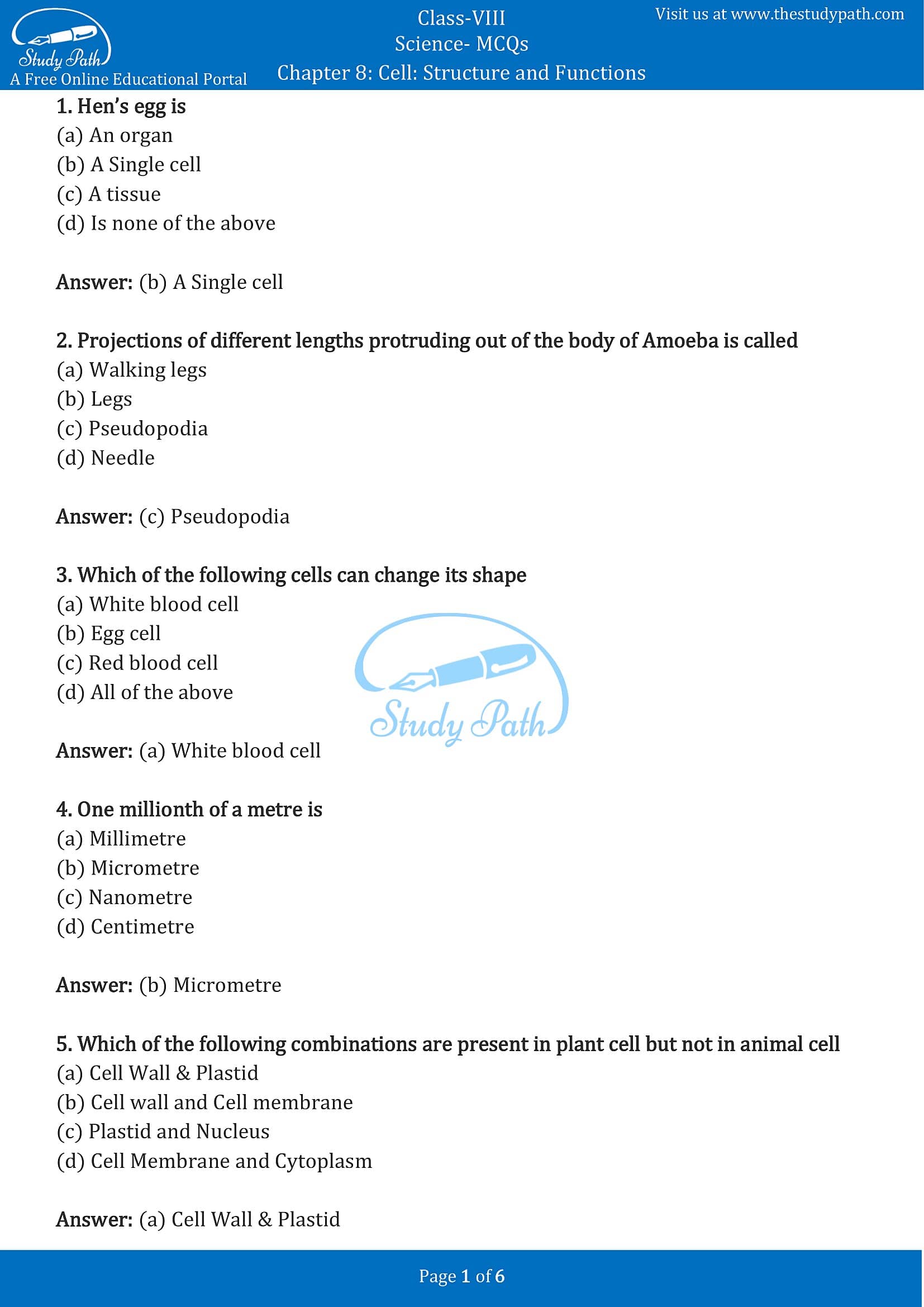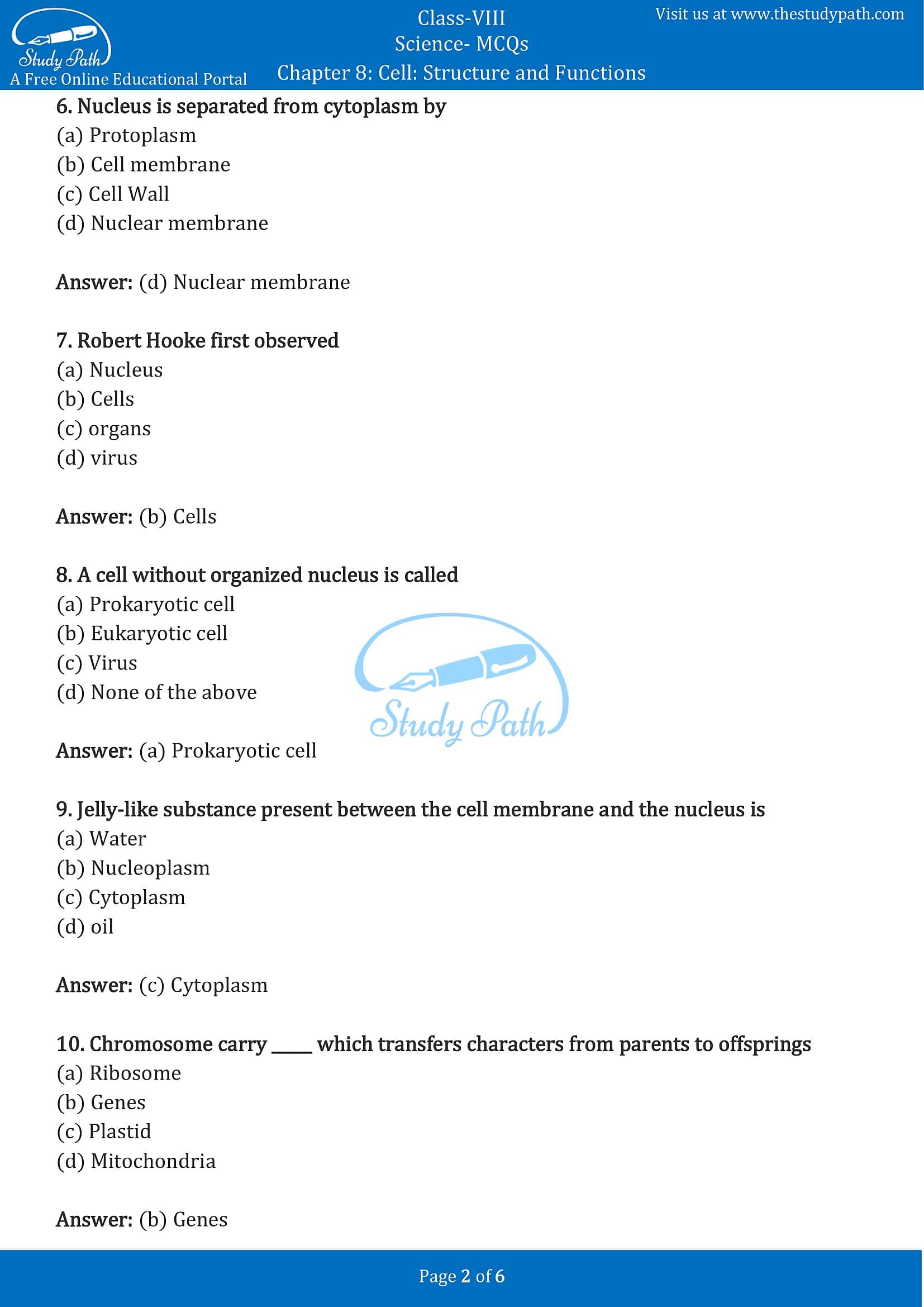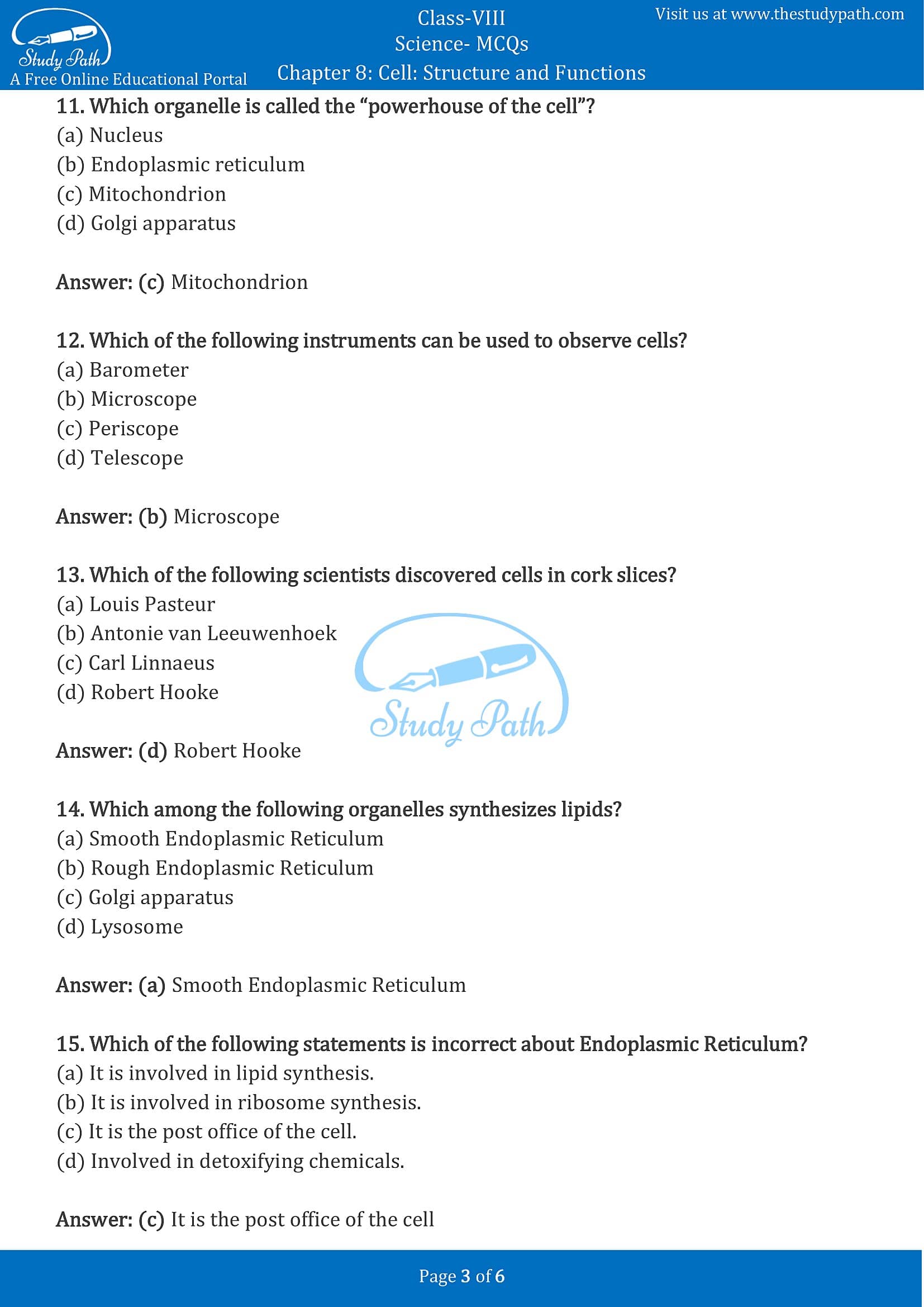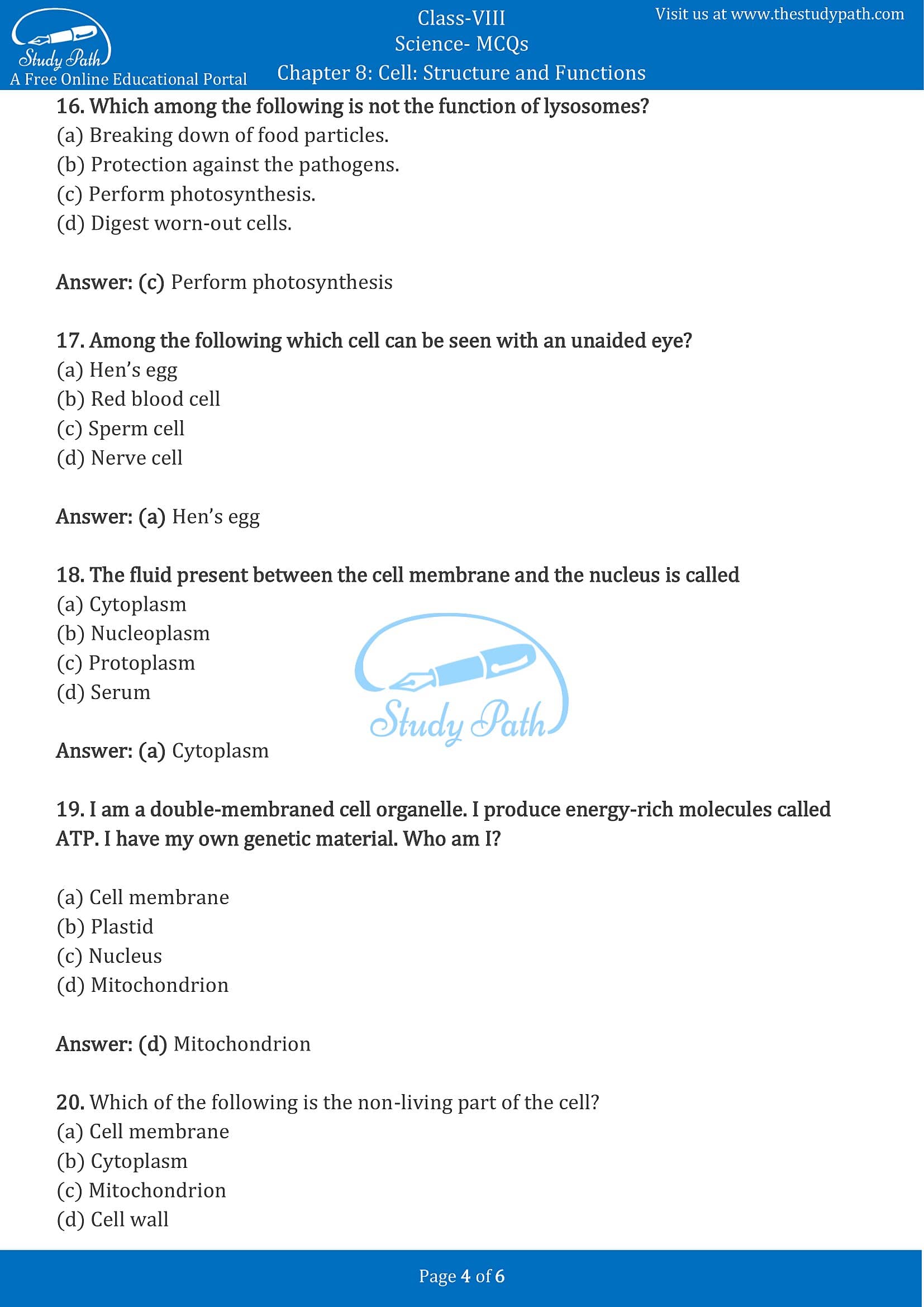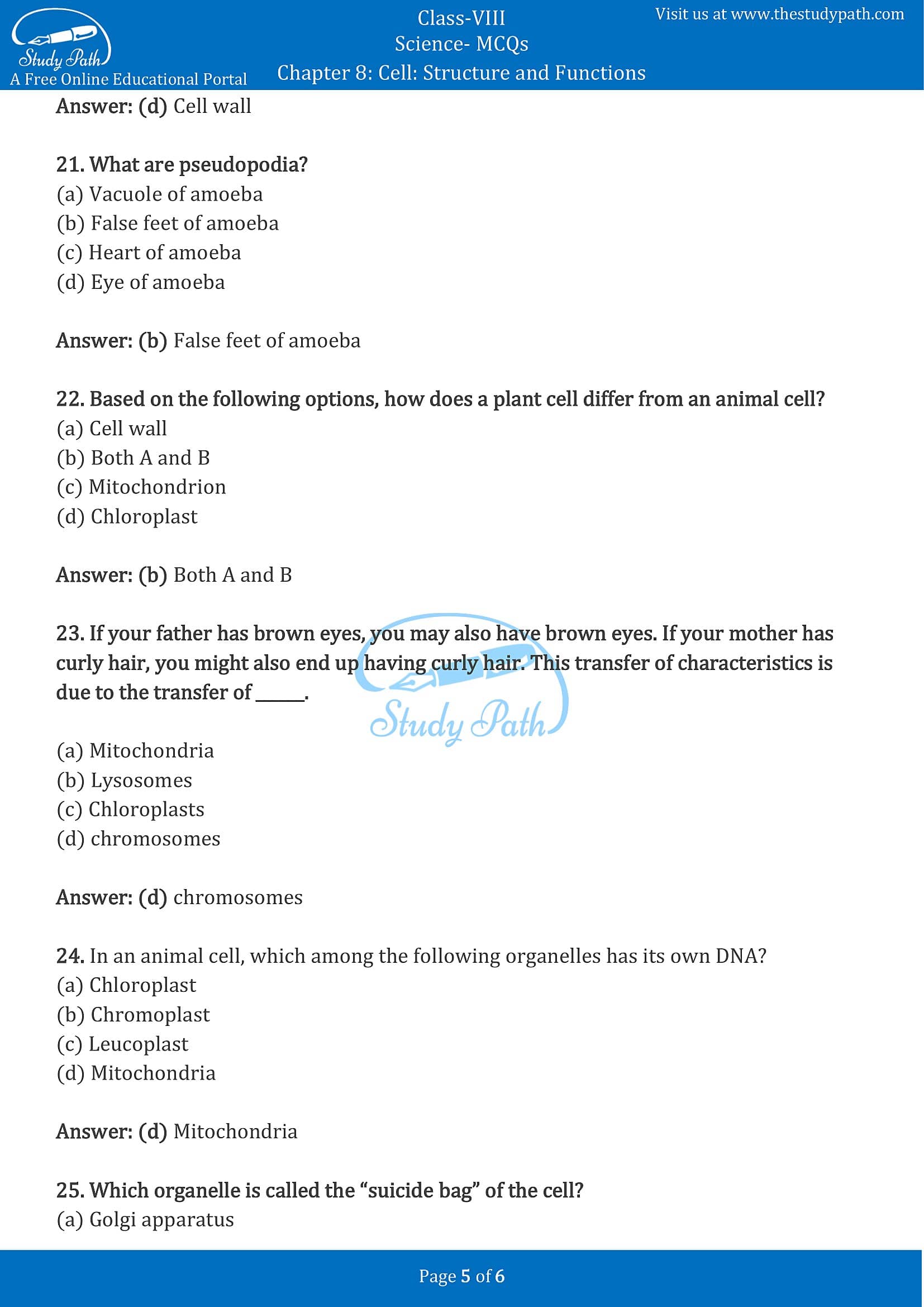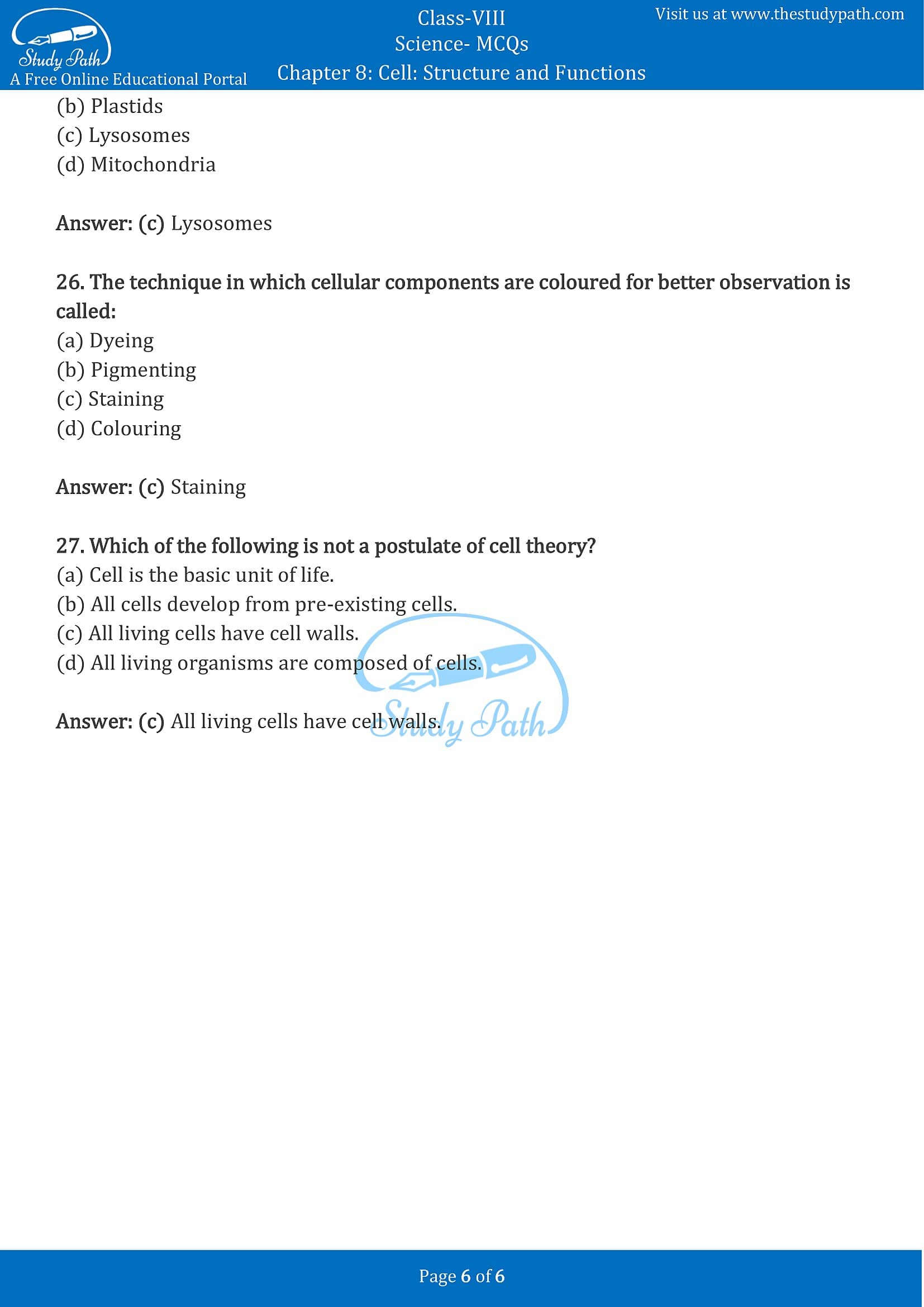Class 8 Science Chapter 8 Cell Structure and Functions MCQ with Answers
Class 8 Science Chapter 8 Cell Structure and Functions MCQ (Multiple Choice Questions) with Answers is available here in PDF format. CBSE Class 8 Science Cell Structure and Functions Objective Questions helps the students to understand the concepts thoroughly and to score good marks. Practising these MCQs will help you to answer every question that is being asked in the exams.
At Study Path, you can download PDF of Multiple Choice Questions for Class 8 Cell Structure and Functions with Answers. These MCQs are prepared on the basis latest exam Pattern. You can solve these MCQs before the exam to know your preparation level.
Cell Structure and Functions Class 8 MCQ with Answers
Multiple Choice Questions (MCQs)
1. Hen’s egg is
(a) An organ
(b) A Single cell
(c) A tissue
(d) Is none of the above
Answer: (b) A Single cell
2. Projections of different lengths protruding out of the body of Amoeba is called
(a) Walking legs
(b) Legs
(c) Pseudopodia
(d) Needle
Answer: (c) Pseudopodia
3. Which of the following cells can change its shape
(a) White blood cell
(b) Egg cell
(c) Red blood cell
(d) All of the above
Answer: (a) White blood cell
4. One millionth of a metre is
(a) Millimetre
(b) Micrometre
(c) Nanometre
(d) Centimetre
Answer: (b) Micrometre
5. Which of the following combinations are present in plant cell but not in animal cell
(a) Cell Wall & Plastid
(b) Cell wall and Cell membrane
(c) Plastid and Nucleus
(d) Cell Membrane and Cytoplasm
Answer: (a) Cell Wall & Plastid
6. Nucleus is separated from cytoplasm by
(a) Protoplasm
(b) Cell membrane
(c) Cell Wall
(d) Nuclear membrane
Answer: (d) Nuclear membrane
7. Robert Hooke first observed
(a) Nucleus
(b) Cells
(c) organs
(d) virus
Answer: (b) Cells
8. A cell without organized nucleus is called
(a) Prokaryotic cell
(b) Eukaryotic cell
(c) Virus
(d) None of the above
Answer: (a) Prokaryotic cell
9. Jelly-like substance present between the cell membrane and the nucleus is
(a) Water
(b) Nucleoplasm
(c) Cytoplasm
(d) oil
Answer: (c) Cytoplasm
10. Chromosome carry _____ which transfers characters from parents to offsprings
(a) Ribosome
(b) Genes
(c) Plastid
(d) Mitochondria
Answer: (b) Genes
11. Which organelle is called the “powerhouse of the cell”?
(a) Nucleus
(b) Endoplasmic reticulum
(c) Mitochondrion
(d) Golgi apparatus
Answer: (c) Mitochondrion
12. Which of the following instruments can be used to observe cells?
(a) Barometer
(b) Microscope
(c) Periscope
(d) Telescope
Answer: (b) Microscope
13. Which of the following scientists discovered cells in cork slices?
(a) Louis Pasteur
(b) Antonie van Leeuwenhoek
(c) Carl Linnaeus
(d) Robert Hooke
Answer: (d) Robert Hooke
14. Which among the following organelles synthesizes lipids?
(a) Smooth Endoplasmic Reticulum
(b) Rough Endoplasmic Reticulum
(c) Golgi apparatus
(d) Lysosome
Answer: (a) Smooth Endoplasmic Reticulum
15. Which of the following statements is incorrect about Endoplasmic Reticulum?
(a) It is involved in lipid synthesis.
(b) It is involved in ribosome synthesis.
(c) It is the post office of the cell.
(d) Involved in detoxifying chemicals.
Answer: (c) It is the post office of the cell
16. Which among the following is not the function of lysosomes?
(a) Breaking down of food particles.
(b) Protection against the pathogens.
(c) Perform photosynthesis.
(d) Digest worn-out cells.
Answer: (c) Perform photosynthesis
17. Among the following which cell can be seen with an unaided eye?
(a) Hen’s egg
(b) Red blood cell
(c) Sperm cell
(d) Nerve cell
Answer: (a) Hen’s egg
18. The fluid present between the cell membrane and the nucleus is called
(a) Cytoplasm
(b) Nucleoplasm
(c) Protoplasm
(d) Serum
Answer: (a) Cytoplasm
19. I am a double-membraned cell organelle. I produce energy-rich molecules called ATP. I have my own genetic material. Who am I?
(a) Cell membrane
(b) Plastid
(c) Nucleus
(d) Mitochondrion
Answer: (d) Mitochondrion
20. Which of the following is the non-living part of the cell?
(a) Cell membrane
(b) Cytoplasm
(c) Mitochondrion
(d) Cell wall
Answer: (d) Cell wall
21. What are pseudopodia?
(a) Vacuole of amoeba
(b) False feet of amoeba
(c) Heart of amoeba
(d) Eye of amoeba
Answer: (b) False feet of amoeba
22. Based on the following options, how does a plant cell differ from an animal cell?
(a) Cell wall
(b) Both A and B
(c) Mitochondrion
(d) Chloroplast
Answer: (b) Both A and B
23. If your father has brown eyes, you may also have brown eyes. If your mother has curly hair, you might also end up having curly hair. This transfer of characteristics is due to the transfer of ______.
(a) Mitochondria
(b) Lysosomes
(c) Chloroplasts
(d) chromosomes
Answer: (d) chromosomes
24. In an animal cell, which among the following organelles has its own DNA?
(a) Chloroplast
(b) Chromoplast
(c) Leucoplast
(d) Mitochondria
Answer: (d) Mitochondria
25. Which organelle is called the “suicide bag” of the cell?
(a) Golgi apparatus
(b) Plastids
(c) Lysosomes
(d) Mitochondria
Answer: (c) Lysosomes
26. The technique in which cellular components are coloured for better observation is called:
(a) Dyeing
(b) Pigmenting
(c) Staining
(d) Colouring
Answer: (c) Staining
27. Which of the following is not a postulate of cell theory?
(a) Cell is the basic unit of life.
(b) All cells develop from pre-existing cells.
(c) All living cells have cell walls.
(d) All living organisms are composed of cells.
Answer: (c) All living cells have cell walls.
At Study Path, you can also learn more about science chapter 8 Cell Structure and Functions by accessing the free exhaustive list of study materials and resources related to the chapter such as NCERT Solutions, Important Questions and Extra Questions.
